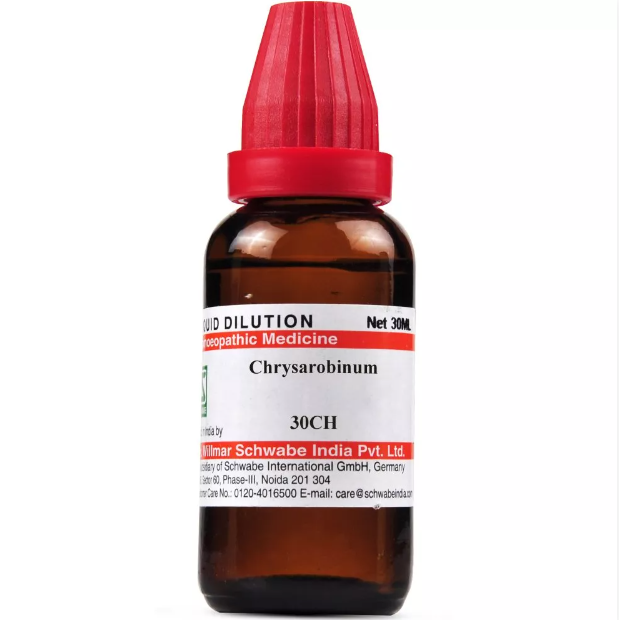CHRYSAROBINUM Q, 6C, 12C, 30C, 200C, 1M, 10M USES AND SYMPTOMS
 Chrysarobinum
Chrysarobinum
(Goa Powder, Andira Araroba)
Chrysar.
Chrysarobinum (Chrysar.) is a potent skin irritant used effectively in treating skin conditions such as ringworm, psoriasis, herpes, and acne rosacea. It causes vesicular or scaly lesions with foul-smelling discharge and crusts that can merge into a single crust covering the entire area. It also causes intense itching in the thighs, legs, and ears, along with dry, scaly eruptions around the eyes and ears, and pus-filled scabs (crusta lactea).
Eyes: Treats blepharitis, conjunctivitis, keratitis, intense photophobia, and optical hyperesthesia.
Ears: Manages eczema behind the ears, resulting in a filthy, scabby condition with thick crust formation, making the ear and surrounding tissue appear as one scab.
Relationship: Chrysarobinum contains chrysophan, which rapidly oxidizes into chrysophanic acid, also found in rhubarb and senna.
Dose: For local application, use 4-8 grains per ounce of vaseline. Internally, use in the third to sixth potency. External use should be cautious due to its potential to cause inflammation.
SYMPTOMS OF CHRYSAROBINUM
Eyes:
Blepharitis (eyelid inflammation).
Conjunctivitis (pink eye).
Keratitis (corneal inflammation).
Intense sensitivity to light (photophobia).
Optical hyperesthesia (increased sensitivity to light).
Ears:
Eczema behind the ears.
Filthy, scabby condition with thick crust formation, making the ear and surrounding tissue appear as one scab.
selection of the potency
Individualization:
- Homeopathy is based on the principle of treating the individual, not just the disease. The unique symptoms and characteristics of the person are crucial in determining the most suitable potency.
Intensity of Symptoms:
- The intensity of the symptoms guides the choice of potency. If the symptoms are intense and acute, a lower potency (e.g., 6C, 30C) might be considered. For chronic conditions with less intensity, higher potencies (e.g., 200C, 1M) may be appropriate.
Sensitivity of the Patient:
- Some individuals are more sensitive to homeopathic remedies, while others may require higher potencies. The practitioner considers the patient’s sensitivity when selecting the potency.
Acute vs. Chronic Conditions:
- Lower potencies are often used for acute conditions, while higher potencies may be considered for chronic or long-standing issues.
Previous Response to Potencies:
- The patient’s response to previous homeopathic treatments helps guide the choice of potency. If a particular potency has been effective in the past, it may be repeated or adjusted as needed.
Vital Force and Susceptibility:
- Homeopathy views illness as a disturbance in the vital force. The practitioner assesses the patient’s overall vitality and susceptibility to determine the appropriate potency.
Aggravation or Amelioration:
- The direction of the symptom response (aggravation or amelioration) after taking a remedy can influence the choice of potency.
Miasmatic Considerations:
- In classical homeopathy, the concept of miasms (inherited disease tendencies) is considered. The practitioner take this into account when selecting the potency.
Practitioner Experience:
- The experience and preference of the homeopathic practitioner play a role. Some practitioners may have success with certain potencies based on their clinical experience.
SAFETY INFORMATION
- Do not exceed the recommended dose by physician
- Keep out of the reach of children
- Store in a cool dry place away from direct sunlight
- Maintain half an hour gap between food/drink/any other medicines and homoeopathic medicine
- Avoid any strong smell in the mouth while taking medicine e.g. camphor, garlic, onion, coffee, hing
Medicine images use for reference only selection of homeopathic medicine depends on the individual’s specific symptoms and overall constitution. Moreover, homeopathy is a holistic system of medicine that treats the individual as a whole. In addition to addressing the physical symptoms, it takes into account the emotional and mental state of the person. Consequently, it’s crucial to consult with a qualified homeopathic practitioner for personalized treatment.
The information provided on this website is intended solely for educational purposes. Always seek the advice of your physician or other qualified health provider.
